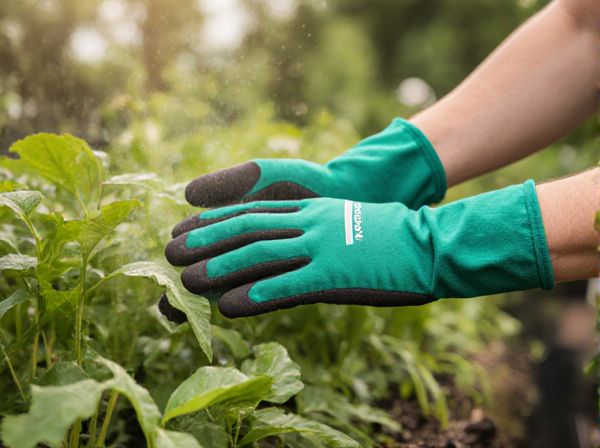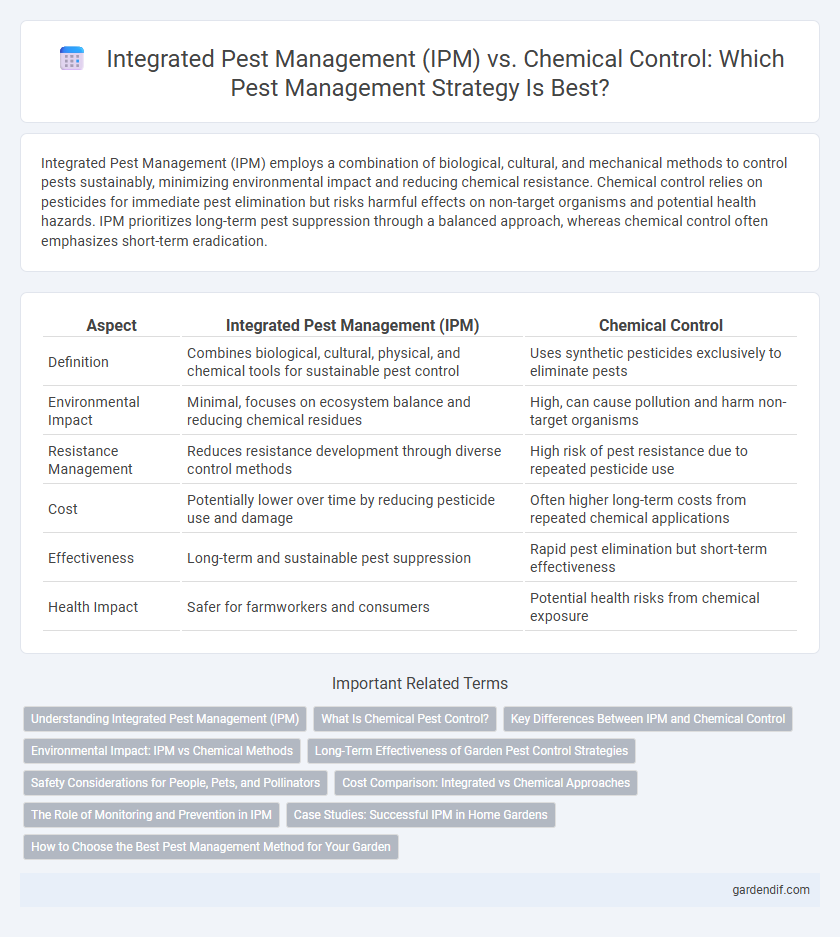
Integrated Pest Management (IPM) vs Chemical Control Illustration
Integrated Pest Management (IPM) employs a combination of biological, cultural, and mechanical methods to control pests sustainably, minimizing environmental impact and reducing chemical resistance. Chemical control relies on pesticides for immediate pest elimination but risks harmful effects on non-target organisms and potential health hazards. IPM prioritizes long-term pest suppression through a balanced approach, whereas chemical control often emphasizes short-term eradication.
Table of Comparison
| Aspect | Integrated Pest Management (IPM) | Chemical Control |
|---|---|---|
| Definition | Combines biological, cultural, physical, and chemical tools for sustainable pest control | Uses synthetic pesticides exclusively to eliminate pests |
| Environmental Impact | Minimal, focuses on ecosystem balance and reducing chemical residues | High, can cause pollution and harm non-target organisms |
| Resistance Management | Reduces resistance development through diverse control methods | High risk of pest resistance due to repeated pesticide use |
| Cost | Potentially lower over time by reducing pesticide use and damage | Often higher long-term costs from repeated chemical applications |
| Effectiveness | Long-term and sustainable pest suppression | Rapid pest elimination but short-term effectiveness |
| Health Impact | Safer for farmworkers and consumers | Potential health risks from chemical exposure |
Understanding Integrated Pest Management (IPM)
Integrated Pest Management (IPM) integrates biological, cultural, mechanical, and chemical tools to manage pest populations sustainably while minimizing environmental impact. IPM emphasizes monitoring pest levels and applying control methods only when necessary, reducing reliance on chemical pesticides. This approach promotes long-term pest control, enhances crop health, and mitigates pesticide resistance and harmful residues.
What Is Chemical Pest Control?
Chemical pest control involves the use of synthetic pesticides to eliminate or suppress pest populations quickly and effectively. It relies on targeted application of insecticides, herbicides, fungicides, and rodenticides to manage pests in agricultural and urban environments. While chemical control provides immediate results, it can lead to pesticide resistance, environmental contamination, and non-target organism harm without proper management.
Key Differences Between IPM and Chemical Control
Integrated Pest Management (IPM) employs a holistic approach combining biological, cultural, mechanical, and chemical methods to minimize pest damage, emphasizing sustainability and environmental safety. Chemical control relies primarily on the application of synthetic pesticides for rapid pest eradication but often leads to pesticide resistance and environmental concerns. IPM prioritizes pest monitoring and threshold-based interventions, whereas chemical control focuses on immediate pest elimination regardless of pest population levels.
Environmental Impact: IPM vs Chemical Methods
Integrated Pest Management (IPM) significantly reduces environmental impact by utilizing biological controls, crop rotation, and habitat management to minimize pesticide use, thereby preserving beneficial insect populations and soil health. Chemical control methods often lead to pesticide runoff, contamination of water sources, and disruption of non-target species, contributing to biodiversity loss and ecosystem imbalance. Implementing IPM practices promotes sustainable agriculture by maintaining ecological integrity and reducing chemical residues in the environment.
Long-Term Effectiveness of Garden Pest Control Strategies
Integrated Pest Management (IPM) emphasizes sustainable, long-term garden pest control by combining biological, cultural, and mechanical methods, reducing pest resistance and environmental impact. Chemical control often provides immediate results but can lead to pest resistance, harming beneficial organisms and disrupting ecosystem balance over time. Research shows IPM strategies maintain garden health more effectively by promoting natural predator populations and minimizing chemical reliance.
Safety Considerations for People, Pets, and Pollinators
Integrated Pest Management (IPM) prioritizes safety by using biological controls, cultural practices, and targeted treatments that minimize harm to people, pets, and pollinators like bees and butterflies. Chemical control often involves broad-spectrum pesticides that pose risks of toxicity, environmental contamination, and harm to non-target species, including beneficial insects and household animals. Implementing IPM reduces exposure to hazardous chemicals, promoting a safer ecosystem and healthier living environments.
Cost Comparison: Integrated vs Chemical Approaches
Integrated Pest Management (IPM) reduces long-term costs by minimizing pesticide usage and promoting sustainable pest control through biological, cultural, and mechanical methods. Chemical control often incurs higher expenses due to frequent pesticide applications, potential pest resistance, and environmental mitigation costs. Over time, IPM provides economic benefits by enhancing crop yields and reducing health risks associated with chemical exposure.
The Role of Monitoring and Prevention in IPM
Monitoring in Integrated Pest Management (IPM) plays a crucial role by providing accurate data on pest populations and their thresholds, allowing for targeted interventions that minimize chemical use. Prevention strategies in IPM focus on habitat manipulation, crop rotation, and resistant varieties to reduce pest establishment and proliferation. This approach contrasts with chemical control, which often relies on routine pesticide applications without real-time pest population insights, increasing the risk of resistance and non-target effects.
Case Studies: Successful IPM in Home Gardens
Case studies highlight successful Integrated Pest Management (IPM) strategies in home gardens, where biological controls, crop rotation, and selective pesticide use effectively reduce pest populations while minimizing environmental impact. Unlike chemical control methods that rely heavily on synthetic pesticides, IPM emphasizes sustainable pest suppression through natural predators and habitat management. These case studies demonstrate improved pest resistance management and healthier garden ecosystems, promoting long-term productivity and biodiversity.
How to Choose the Best Pest Management Method for Your Garden
Integrated Pest Management (IPM) combines biological controls, cultural practices, and minimal chemical use to effectively reduce pest populations while preserving beneficial insects and promoting long-term garden health. Chemical control offers rapid and targeted pest elimination but may lead to resistance development and environmental harm if overused. Choosing the best method depends on pest severity, garden size, and ecological impact, with IPM preferred for sustainable gardening and chemical control reserved for severe infestations.
Integrated Pest Management (IPM) vs Chemical Control Infographic

 gardendif.com
gardendif.com